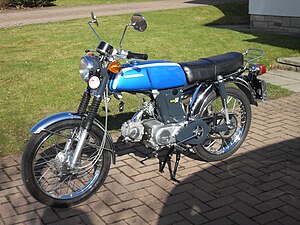Honda SS50
This article needs additional citations for verification. (February 2012) |
 Fully restored 1975 Honda SS50ZK1-e (UK 4-speed) | |
| Manufacturer | Honda Motor Company |
|---|---|
| Predecessor | Honda SS50 |
| Class | Motorcycle |
| Engine | 49 cc (3.0 cu in), four stroke, air-cooled, OHC, single[1] |
| Transmission | 4-speed, later 5-speed, manual via chain[1] |
| Frame type | Pressed-steel |
| Suspension | Hydraulic, front and rear |
| Brakes | Drum, later front disc/rear drum |
| Wheelbase | 1.180 m (46.5 in) |
| Dimensions | L: 1.840 m (72.4 in) H: 1.020 m (40.2 in) |
| Seat height | 0.750 m (29.5 in) |
| Weight | 76 kg (168 lb)[citation needed] (dry) |
| Fuel capacity | 7 L (1.5 imp gal; 1.8 US gal) |
| Oil capacity | 0.7 L (0.15 imp gal; 0.18 US gal) |

The Honda SS50 is a 50 cc (3.1 cu in) motorcycle manufactured by the Honda Motor Company.
Predecessors were the OHV C110/C11/C114 and OHC S50. Produced from 1961 onwards, the Honda 50 Sport (type C110 and C111) variant of the Super Cub, laid out the basics of all future models: It had a pressed-steel frame, hydraulic front and rear forks, a 49 cc (3.0 cu in) OHV four-stroke engine. The cylinder was laid horizontally to optimise cooling. The final drive was chain running in an enclosed chain case. The S50 featured an all-new OHC alloy head engine.
The SS50 replaced these in the late 1960s, using a new T-shaped frame with separate rear mudguard, and telescopic front forks to replace the leading links.
SS50[edit]
The SS50 replaced the OHV C110 and derivatives, with the SS standing for "Super Sports". Basically with the same form as the S50, it had a few upgrades:[1]
The first SS50s in the late 1960s, were delivered with chrome panelled tank, and frame painted in the same colour as the tank's paintwork. Later on they got a longer, thinner 7 L (1.5 imp gal; 1.8 US gal) petrol tank in red, blue or yellow and a grey frame, and chromed mudguards. Introduced with a four-speed gearbox, the handlebar controls and switches corresponded to the high level of other Honda motorcycle models, made from cast aluminum, and a standard rear-view mirror. All three of these bikes came complete with a chromed high level exhaust and heat shield.
The later five-speed SS50 had an extra gear and the engine was also tuned up making it faster and more competitive in the UK market. The frames of the later five-speed models were black differing to the grey of the four-speed. The last five-speed versions had a front disc brake instead of the twin drums used earlier..
As a moped, to comply with the legal requirements in the United Kingdom and some other European countries, the SS50 was available with a pair of bicycle-like pedals. The special pedal cranks allowed both pedals to be rotated forward, so that the pedals would form motorcycle-style footrests in normal operation.
All Mopeds registered in the UK after 1 September 1977 were restricted to a maximum of 31 miles per hour (50 km/h), but did not legally need bicycle pedals.[2]
Competition[edit]
The Honda SS50 varied greatly from its competitors in using a four-stroke engine, its global competitors the Suzuki AP50 - A50II and the Yamaha FS1E "Fizzy" used two-stroke engines. This made the SS50 slower on acceleration, but more reliable and economical.[2]
Related models[edit]
The SS50 49 cc engine was also used in numerous related models including the ST series (minibike) and the Z series "monkey".[1][2]
In Vietnam[edit]
The Honda SS50 is commonly known as a Honda 67, later Honda 72 (SS50V 1972 model) in Vietnam, particularly in the South.[3]
See also[edit]
References[edit]
- Footnotes
- ^ a b c d Stewart W. Wilkins (30 May 1975). Haynes Owners Workshop Manuals - Honda SS50. J H Haynes & Co Ltd. ISBN 0-85696-167-1.
- ^ a b c Skelton, Richard (November 2004). Funky Mopeds: The 1970s Sports Moped Phenomenon. Veloce Publishing. ISBN 1904788114.
- ^ "Honda 67 collection rare and priceless". Retrieved 2016-08-24.
- Sources
- Stewart W. Wilkins (30 May 1975). Haynes Owners Workshop Manuals - Honda SS50. J H Haynes & Co Ltd. ISBN 0-85696-167-1.
